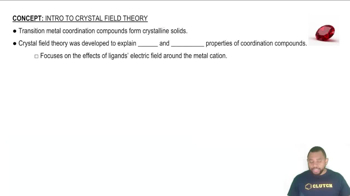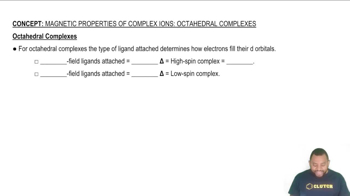Here are the essential concepts you must grasp in order to answer the question correctly.
Crystal Field Theory
Crystal Field Theory (CFT) explains how the arrangement of ligands around a central metal ion affects its electronic structure and energy levels. In octahedral complexes, the d-orbitals split into two energy levels: the lower-energy t2g and the higher-energy eg. The extent of this splitting is influenced by the nature of the ligands, determining whether electrons will pair up in the lower energy orbitals or occupy higher energy orbitals.
Recommended video:
The study of ligand-metal interactions helped to form Ligand Field Theory which combines CFT with MO Theory.
High Spin vs. Low Spin Complexes
High spin and low spin complexes refer to the arrangement of electrons in d-orbitals based on the strength of the ligands. High spin complexes have fewer paired electrons and result from weak field ligands that cause less splitting of d-orbitals, allowing electrons to occupy higher energy levels. Conversely, low spin complexes have more paired electrons due to strong field ligands that cause greater splitting, favoring electron pairing in the lower energy orbitals.
Recommended video:
For octahedral complexes, Weak-Field Ligands create High-spin complexes and Strong-Field Ligands create Low-spin complexes.
Spectrochemical Series
The spectrochemical series is a list that ranks ligands based on their ability to split the d-orbitals of a metal ion. Strong field ligands, like CN⁻, cause large splitting and lead to low spin configurations, while weak field ligands, like I⁻, cause small splitting and favor high spin configurations. The position of NCS⁻ in this series indicates its relative strength as a ligand, influencing the electronic configuration and magnetic properties of the resulting complex.
Recommended video:

 Verified step by step guidance
Verified step by step guidance

